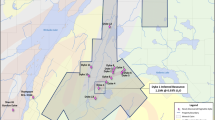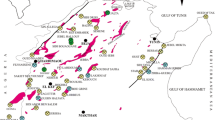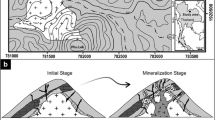Abstract
A kyanite mine in central Virginia produces a silicate-rich waste stream which accumulates at a rate of 450,000–600,000 tons per year. An estimated 27 million tons of this waste stream has accumulated over the past 60 years. Grain size distribution varies between 1.000 and 0.053 mm, and is commonly bimodal with modes typically being 0.425 and 0.250 mm and uniformity coefficients vary from 2.000 to 2.333. Hydraulic conductivity values vary from 0.017 to 0.047 cm/s. Mineralogy of the waste stream consists of quartz, muscovite, kyanite and hematite. Muscovite grains have distinct chemical compositions with significant Na2O content (1.12–2.66 wt%), TiO2 content (0.63–1.68 wt% TiO2) and Fe content, expressed as Fe2O3 (up to 1.37 wt%). Major element compositions of samples were dominated by SiO2 (87.894–90.997 wt%), Al2O3 (6.759–7.741 wt%), Fe2O3 (1.136–1.283 wt%), and K2O (0.369–0.606 wt%) with other components being <1.000 wt%. Elements of environmental concern (V, Cr, Ni, Cu, Zn, As, Ag, Sn, Sb, Ba, Hg, Tl, and Pb) were detected; however, the concentrations of all elements except Ni were below that of the kyanite quartzites in the region from which the waste is derived. Both major and trace element compositions indicate minimal variation in composition. The waste stream has potential for recycling. Muscovite is suitable for recycling as a paint pigment or other industrial applications. Muscovite and hematite are commonly intergrown and are interpreted to be material where much of the elements of environmental concern are concentrated. Reprocessing of the waste stream to separate muscovite from other components may enable the waste stream to be used as constructed wetland media for Virginia and nearby states. Recycling of this mine waste may have a positive impact on the local economy of Buckingham County and aid in mitigation of wetland loss.



Similar content being viewed by others
References
Arias CA, Del Bubba M, Brix H (2001) Phosphorous removal by sands for use as media in subsurface flow constructed reed beds. Water Res 35:1159–1168
Bian ZF, Dong JH, Lei SG, Leng HL, Mu SG, Wang H (2009) The impact of disposal and treatment of coal mining wastes on environment and farmland. Environ Geol 58:625–634
Brown MT (2005) Landscape restoration following phosphate mining: 30 years of co-evolution of science industry and regulation. Eco Eng 24:309–329
Brunori C, Cremisini C, Massanisso P, Pinto V, Torricelli L (2005) Reuse of a treated red mud bauxite waste: studies on environmental compatibility. J Hazard Mater 117:55–63
Burton A (2009) Global agreement to control mercury pollution. Front Ecol Environ 7:121
Cabral AR, Lehmann B, Galbiatti HF, Rocha Filho OG (2006) Evidence for metre-scale variations in hematite composition within the Palaeoproterozoic Itabira iron formation, Minas Gerais, Brazil. Mineral Mag 70:591–602
Cavalcante PMT, Dondi M, Guarini G, Barros FM, da Luz AB (2007) Ceramic application of mica titania pearlescent pigments. Dyes Pigments 74:1–8
Chabu M, Boulegue J (1992) Barian feldspar and muscovite from the kipushi Zn–Pb–Cu deposit, Shaba, Zaire. Can Mineral 30:1143–1152
Danish EPA (1999) Rodzoneanlae op til 30 PE Environ Guidelines 1: 1–46
Davis A, Drexler JW, Ruby MV, Nicholson A (1993) Micromineralogy of mine wastes in relation to lead bioavailability, Butte, Montana. Environ Sci Technol 27:1415–1425
Dinelli E, Lucchini F, Fabbri M, Cortecci G (2001) Metal distribution and environmental problems related to sulfide oxidation in the Libiola copper mine area (Ligurian Apennines, Italy). J Geochem Explor 74:141–152
Dobbie KE, Heal KV, Aumonier J, Smith KA, Johnston A, Younger PL (2009) Evaluation of iron ochre from mine drainage treatment for removal of phosphorus from wastewater. Chemosphere 75:795–800
Dold B, Fontbote L (2001) Element cycling and secondary mineralogy in porphyry copper tailings as a function of climate, primary mineralogy, and mineral processing. J Geochem Explor 74:3–55
Dold B, Fontbote L (2002) A mineralogical and geochemical study of element mobility in sulfide mine tailings of Fe oxide Cu–Au deposits from the Punta del Cobre belt, northern Chile. Chem Geol 189:135–163
Driussi C, Jansz J (2006) Technological options for waste minimization in the mining industry. J Clean Prod 14:682–688
Feng XR, Qiu GL, Fu XW, He TR, Li P, Wang SF (2009) Mercury pollution in the environment. Prog Chem 21:436–457
Fitzgerald WF, Engstrom DR, Mason RP, Nater EA (1998) The case for atmospheric mercury contamination in remote areas. Environ Sci Technol 32:1–7
Foster AL, Brown GE, Tingle TN, Parks GA (1998) Quantitative arsenic speciation in mine tailings using X-ray absorption spectroscopy. Am Mineral 83:553–568
Gilbert SG, Grantwebster KS (1995) Neurobehaviorial effects of developmental methylmercury exposure. Environ Health Persp 103:135–142
Graeser S, Hetherington CJ, Giere R (2003) Ganterite, a new barium dominant analogue of muscovite from the Berisal Complex, Simplon region, Switzerland. Can Mineral 41:1271–1280
Grapes RH (1993) Barian mica and distribution of barium in metacherts and quartzofeldspathic schists, southern Alps, New Zealand. Mineral Mag 57:265–272
Guidotti CV, Cheney JT, Guggenheim S (1977) Distribution of titanium between coexisting muscovite and biotite in politic schists from northwestern Maine. Am Mineral 62:438–448
Hamilton EI (2000) Environmental variables in a holistic evaluation of land contaminated by historic mine wastes: a study of multi-element mine wastes in West Devon England using arsenic as an element of potential concern to human health. Sci Tot Environ 249:171–221
Hancock GR, Turley E (2006) Evaluation of proposed waste rock dump designs using the SIBERIA erosion model. Environ Geol 49:765–779
Hancock GR, Evans KG, Willgoose GR, Moliere DR, Saynor MJ, Loch RJ (2000) Medium-term erosion simulation of an abandoned mine site using the SIBERIA landscape evolution model. Aust J Soil Res 38:249–263
Hazen A (1911) Discussion of Dams on sand foundation. Trans Am Soc Civ Eng 73:199–203
Hudson-Edwards KA, Schell C, Macklin MG (1999) Mineralogy and geochemistry of alluvium contaminated by metal mining in the Rio Tinto area, southwest Spain. Appl Geochem 14:1015–1030
Jung JH, Yoo JW, Lee JU, Kim HT (2005) Application of coal wastes to clay bricks and investigation of their physical properties. J Ind Eng Chem 11:175–179
Kalenda P, Kalendova A, Stengl V, Antos P, Subrt J, Kvaca Z, Bakardjieva S (2004) Properties of surface-treated mica in anticorrosive coatings. Prog Org Coat 49:137–145
Kolker A, Engle MA, Orem WH, Bunnell JE, Lerch HE, Krabbenhoft DP, Olson ML, McCord JD (2008) Mercury, trace elements and organic constituents in atmospheric fine particulate matter, Shenandoah National Park, Virginia, USA: a combined approach to sampling and analysis. Geostand Geoanal Res 32:279–293
Koneva AA (2002) Cr-V oxides in metamorphic rocks, Lake Baikal, Russia. Neues Jb Miner Monat 12:541–550
Krekeler MPS, Morton J, Lepp J, Tselepis CM, Samsonov M, Kearns LE (2008) Mineralogical and geochemical investigation of clay-rich mine tailings from a closed phosphate mine, Bartow Florida, USA. Environ Geol 55:123–147
Krekeler MPS, Allen CS, Kearns LE, Maynard JB (2009) An investigation of aspects of mine waste from a kyanite mine, Central Virginia, USA. Env Ear Sci. doi:10.1007/s12665-009-0324-x
Langmuir D (1997) Aqeuous environmental chemistry. Prentice Hall, USA 600p
Li P, Feng XB, Qiu GL, Shang LH, Li ZG (2009) Mercury pollution in Asia: a review of the contaminated sites. J Hazard Mater 168:591–601
Marabini AM, Plescia P, Maccari D, Burragato F, Pelino M (1998) New materials from industrial and mining wastes: glass-ceramics and glass- and rock-wool fibre. Int J Miner Process 53:121–134
Marescotti P, Carbone C, De Capitani L, Grieco G, Lucchetti G, Servida D (2008) Mineralogical and geochemical characterization of open-air tailing and waste-rock dumps from the Libiola Fe–Cu sulphide mine (Eastern Liguria, Italy). Environ Geol 53:1613–1626
Meck M, Love D, Mapani B (2006) Zimbabwean mine dumps and their impacts on river water quality—a reconnaissance study. Phys Chem Earth 31:797–803
Oelkers E, Schott J (1999) Experimental study of kyanite dissolution rates as a function of chemical affinity and solution composition. Geochem Cosmochim Acta 63:785–797
Owens BE, Dickerson SE (2001) Kyanite color as a clue to contrasting protolith compositions for kyanite quartzites in the Piedmont Province of Virginia. Southeast Geol 40:285–298
Owens BE, Pasek MA (2007) Kyanite quartzites in the Piedmont Province of Virginia: evidence for a possible high sulfidation system. Econ Geol 102:495–509
Pain DJ, Sánchez A, Meharg AA (1998) The Doñana ecological disaster: contamination of a world heritage estuarine marsh ecosystem with acidified pyrite mine waste. Sci Tot Environ 222:45–54
Patra M, Sharma A (2000) Mercury toxicity in plants. Bot Rev 66:379–422
Puziewicz J, Koepke J (1991) Controls on TiO2 content in muscovite and biotite from a 2-mica granite, the Strzegom–Sobotka Massif, Sudetes, SW Poland. Neues Jb Miner Monat 6:253–261
Ratcliffe HE, Swanson GM, Fischer LJ (1996) Human exposure to mercury: a critical assessment of the evidence of adverse health effects. J Toxicol Environ Health 49:221–270
Ribet I, Ptacek CJ, Blowes DW, Jambor JL (1995) The potential for metal release by reductive dissolution of weathered mine tailings. J Contam Hydrol 17:239–273
Ritcey GM (2005) Tailings management in gold plants. Hydrometallurgy 78:3–20
Secco L, Nestola F, Dal Negro A, Reznitsky (2008) Crystal chemistry study of R3c natural oxides along the eskolaite–karelianite–hematite (Cr2O3–V2O3–Fe2O3) join. Mineral Mag 72:785–792
Sheperd RG (1989) Correlations of permeability and grain size. Ground Water 275:633–638
Slemr F, Langer E (1992) Increase in global atmospheric concentrations of mercury inferred from measurements over the Atlantic Ocean. Nature 355:434–437
Smith ML, Williams RE (1996a) Examination of methods for evaluating remining a mine waste site. Eng Geol 43:11–21
Smith ML, Williams RE (1996b) Examination of methods for evaluating remining a mine waste site. Part II. Indicator kriging for selective remediation. Eng Geol 43:23–30
Souza LPD, Mansur HS (2004) Production and characterization of ceramic pieces obtained by casting using powder wastes. J Mater Process Tech 145:14–20
Spears DB, Upchurch ML (1997) Metallic mines, prospects, and occurrences in the Gold-pyrite belt of Virginia: Virginia Division of Mineral Resources Publication 147, 73p
Sweet PC (1980) Gold in Virginia: Virginia Division of Mineral Resources Publication 19, 77p
Sweet PC, Trimble D (1983) Virginia gold-resource data: Virginia Division of Mineral Resources Publication 45 196p
U.S. Census Bureau (2000a) American FactFinder. Buckingham County, Virginia
U.S. Census Bureau (2000b) American FactFinder. Dillwyn, Virginia
USGS Minerals Yearbook 2010. Mineral Commodity Summaries, pp 86–87
Virginia. Code. §9VAC25-210-116. Compensation
Yoo JW, Jung JH, Kim HT (2005) Synthesis and characterization of clay brick using coal wastes. In Kim HS, Park SY, Hur BY (eds) Eco-materials processing & Design VI. Material Science Forum, vol 486–487, pp 403–406
Author information
Authors and Affiliations
Corresponding author
Rights and permissions
About this article
Cite this article
Geise, G., LeGalley, E. & Krekeler, M.P.S. Mineralogical and geochemical investigations of silicate-rich mine waste from a kyanite mine in central Virginia: implications for mine waste recycling. Environ Earth Sci 62, 185–196 (2011). https://doi.org/10.1007/s12665-010-0513-7
Received:
Accepted:
Published:
Issue Date:
DOI: https://doi.org/10.1007/s12665-010-0513-7




